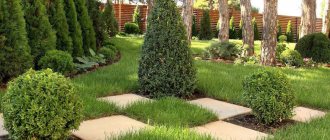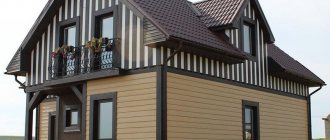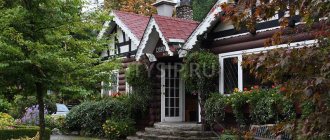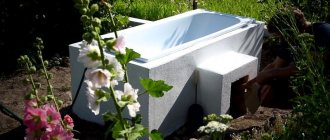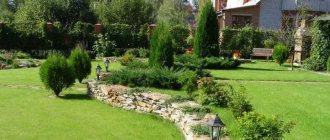When creating their own garden on a summer cottage or next to a country cottage, any owner strives to make it beautiful. True, some prefer to devote a large area to a vegetable garden with vegetable beds, others to fruit and berry plantings, and still others to a recreation area. But, as a rule, no one can do without flowers.
Flowering plants are for a landscape designer what paints are for an artist.
Features of flower arrangements in the garden at the dacha
Flower arrangements in the garden and at the dacha can be different. If the garden is large, then in addition to flowers there will probably be plantings of trees and shrubs, a lawn, often a swimming pool, gazebos, and paths. And in this case, it is important that the flower arrangements are in harmony with all other elements of the landscape in the garden.
Even a beginner can create a flower garden on his own site, but it is important that the plants really decorate the garden, and do not make it overly colorful and tasteless
It’s good if a landscape designer takes part in the project. But even if the owners do the design themselves, they can beautifully and competently fit all the garden compositions into their summer cottage. If, instead of a large garden, there is just a small dacha, mainly with vegetable beds, then here too it is quite possible to make beautiful islands by placing flowers in the garden near the house. Any flower compositions in the garden and country house are designed to be beautiful and pleasing to the eye. Therefore, it is important to choose the right plants, according to flowering time, shades, height, so that they form harmonious combinations.
You can make any area lighter and more spacious with the help of herbaceous plants blooming with white or yellow inflorescences.
A decorative border of flowers can decorate any garden path
What trees are not advisable to plant near the house and why?
Some representatives of the flora are not recommended to be planted near the house. Some - due to natural reasons, others - due to superstition.
Giants with powerful roots should not be placed close to buildings. Over time, the root system can develop and go so deep that it disturbs the foundation of the building. These include poplar or walnut.
It is better not to plant pine trees on the site, or to distance them as much as possible. Their features are such that they can destroy all the vegetation around them.
Plants are believed to have a certain energy. Everyone's aura is special and can give or take away strength. According to superstitions, it is undesirable to plant the following flora representatives near the house.
Birch
In fact, birch is a real protector. However, it is better to take it outside the gate and build a bench next to it. There she will not disturb the owner and will not let negativity enter the doorstep.
Aspen
Our ancestors also considered aspen an energy vampire. According to legends, she brings illness and loss. The cross of Jesus Christ was made of aspen.
Willow
Some say that whoever plants it will soon suffer death. Even if you are not a superstitious person, you should not tempt fate.
Willow
It often grows near bodies of water, but is not suitable for planting near a house. The willow tree is traditionally considered a symbol of crying and suffering; in the old days, women came to it to grieve over their difficult fate.
The most popular types of flowers for garden decoration
There are a variety of flowers placed in the garden plot. Popular perennials include delphiniums, lilies, roses (some varieties of these flowers can be grown both at home and in the garden), phlox, tulips, lilies of the valley, peonies, gypsophila, astilbe, and hydrangea.
Spring tulips are deservedly popular among gardeners.
Of the annuals, the most common are marigolds, cosmos, poppies, calendula, petunias, morning glory, and nasturtium. They do not require special care and even an inexperienced gardener can cope with planting.
It's hard to imagine a summer cottage without delicate peonies
Popular climbing plants include sweet peas, wisteria, and clematis. Irises, loosestrife, and marigold are planted near ponds and streams. In the shady garden there are ferns and hostas. Juveniles, alyssum, carnations, tulips, and haretail are suitable for alpine hills.
Luxurious lashes of climbing roses will decorate the fence, which, in turn, will serve as a support for the plant
Before planting certain flowers nearby, you need to carefully consider how they will combine with each other in color, height, and how they will harmonize with other elements of the landscape. To do this, you need to look at the detailed description of the species.
Clematis will be a chic decoration for a pergola or the wall of a country house
Which trees are suitable for lowlands and wetlands?
The best option for a garden is a perfectly flat terrain. However, not every plot of land can boast of such characteristics. Most often, there are lowlands near the estate, which need to be filled correctly.
You should not build a garden in a low-lying area. Fruit trees and shrubs are demanding of soil, and in damp and high humidity conditions their roots will begin to rot. Groundwater must lie at least 2 m deep from the surface of the earth.
If the entire garden is in a lowland, but you want to plant fruit crops, use the following technique. Make earthen mounds 35-45 cm high and place the seedlings on artificially created hills.
If there is a low area on the site, and it is not possible to create a good drainage system, certain plants are specially planted. Aspen or willow will help remove excess water.
There are other representatives of the flora that tolerate low-lying areas and nearby streams well:
- Spiraea Douglas. A beautiful deciduous plant, famous for its long flowering period from July to September. Perfectly complements the green design.
- White willow. A tree traditionally found in marshy soils along rivers and streams. Thanks to its impressive size, it creates a noticeable shadow.
- Hawthorn. A shrub strewn with fruits that resemble small apples. Often used for medicinal purposes.
- Gray alder. A tree that grows up to 20 m. It does not tolerate drought, so damp soils are what you need.
- Honeysuckle. It is of interest as an ornamental plant. There are varieties with edible fruits of unusual shape.
- Deren. Common types include white, red and scion derain. It is distinguished by its unpretentiousness and high adaptability.
- Kalina. Every owner will be pleased to have viburnum on their territory. This unusually beautiful shrub will delight you with useful fruits.
Planting plants in wetlands will help reduce moisture levels and add greenery to the area. Trees will help achieve completeness and integrity.
Tips and tricks for using flower beds
In order for a flower bed to please the eye for a long time, you need, firstly, to take into account the flowering periods of different types of plants. Sometimes they are planted in such a way that when some fade, others immediately bloom, so that “emptiness” is not created. Sometimes long-flowering plants are selected, with the same flowering period, combined in color. Together they create the desired accent in the landscape.
Unpretentious wildflowers will add special summer romance to your yard
It is also necessary to take into account the ecological characteristics of the species: you should not plant moisture-loving and drought-resistant species in the same flowerbed; shade-tolerant and light-loving. In addition, it is worth remembering that the most beautiful and vibrant flower beds will look best against the background of a plain lawn with lush greenery, or next to dark green conifers, or framed by herbaceous green plants. Also, any flower bed, even with the most unassuming plant species, requires at least minimal care - periodic weeding, fertilizing, removing dead stems, flowers and leaves.
A simple flower bed with bright flowers around the edges will adequately decorate a lawn in a suburban area
Creating beautiful flower arrangements in your dacha garden is not that difficult. There can be a lot of design options depending on the preferences of the owners, area of the site, budget, environmental and geographical features of the area.
Selection of trees according to climate zone
Before purchasing seedlings, choose them rationally. Southern heat-loving specimens quickly die or do not take root at all in cold areas. Gardeners often unsuccessfully try to grow fruit crops that are sensitive to air temperature in their dachas.
Trees for northern latitudes
Among the decorative representatives of the flora, the following common species tolerate cold climates well:
- black or Russian willow
- broom
- Rowan
- white acacia
- birch (various varieties)
- blue spruce
- Norway maple
- thuja
- oak
- Amur velvet
Things are more difficult with fruit trees. Most of them die in icy winters. Pay attention to nuts, resistant varieties of apple trees, hawthorn, lingonberries, and blueberries. Now there are other fruit crops on the market that are adapted to harsh conditions.
Trees for mid-latitudes
In the temperate climate zone, the choice for planting green spaces is huge. Broad-leaved (beech, ash, linden), coniferous (spruce, pine), small-leaved (aspen, birch) species, as well as most fruit representatives, take root well.
If severe frosts occur in mid-latitudes, they last only a short time. In temperate zones, temperatures can drop to -25-30 C. Therefore, choose plants that can withstand such cold weather.
Trees for the south lane
Warm weather conditions with little temperature variation are the ideal place to create a fertile garden.
In the south, heat-loving plants develop and bear fruit well:
- peaches
- apricots
- cherries
- pears
- quince
- cherries
- dogwood
- sea buckthorn
- barberry
- mulberry
- honeysuckle
- plum
When choosing seedlings, objectively assess the climate in which the plant will have to live. Buy the most adapted varieties. Don’t give in to the desire to do the impossible and grow something completely exotic.
Photos of beautiful flower beds in suburban areas
Optimal bed sizes
The beds need to be planned in such a size that they are easy to care for: sowing, planting seedlings, weeding and reaching with a watering can.
Therefore, the ideal dimensions are width 80 cm, length 3-4 m, height 35 cm (for beds with a fence). If you have a lot of children’s helpers, for example, during the holidays, grandchildren and children help with weeding, then the best width is 70 cm.
With such dimensions, it is convenient for everyone to reach with their hand from each side of the row spacing to the middle of the bed.
The maximum permissible width of the bed is 1 m, for cabbage, which is planted in two rows, 100-120 cm can be allocated. The width of the rows is at least 30 cm, optimally 40 cm, if a wheelbarrow needs to drive up to the bed, then 50 cm. These dimensions are for a small vegetable garden , where every centimeter is precious. If your area is quite large, feel free to leave passages 60-80 cm wide.
What plants are grown to create a spectacular hedge?
Low decorative shrubs for summer cottages and personal plots can be used as hedges. In this case, all created green fences are divided into two large groups. The first is molded; this type of fence is trimmed regularly during the growing season. The second is unshaped; pruning is not applied to plantings of this type; they independently form linear shapes.
Beautifully decorated shrubs near the house
Beautiful combination of shrubs on the site
Green and aromatic crops
Not all aromatic herbs are equally easy to grow. Among the simplest, and therefore ideal for a novice summer resident, dill and parsley come first. They are quite cold-resistant, so you can start sowing seeds in open ground as early as April. These herbs will grow best in a sunny location. They usually begin to pick young greens a month and a half after sowing.
It is no more difficult than dill and parsley to grow green crops such as sorrel and lettuce. They are absolutely unpretentious to growing conditions. Water them, remove weeds from time to time - and these crops will thank you with abundant greenery. Sowing can begin at the end of April. Lettuce seeds should not be sown all at the same time - do it every 2 weeks. In this case, you will have fresh greens with soft, tender leaves on the table throughout the summer.
- Early greens for sale - learning to grow
Greens grown for sale should be vibrant, healthy and inexpensive. You will be glad to know that this is possible and takes minimal time.
Potato
The main problem when growing potatoes is the Colorado potato beetle. However, it can be successfully combated, especially in small beds, without even using chemicals. To do this, walk around your plantings every day and manually collect pests in any container filled with soap solution or kerosene. From time to time, throw out dead beetles from there.
Otherwise, growing potatoes is not an extremely difficult task. In addition to standard weeding, potato bushes need hilling. Thanks to this procedure, the formation of tubers is activated, which means the yield increases.
- Traditional and new methods of growing potatoes: pros and cons of each
There is no gardener who has never grown potatoes in his life. But people tend to strive for perfection in everything. Growing potatoes is no exception. Today, many summer residents know how to get maximum yield from a small plot!
Mixborder placement
Before you start selecting plants, evaluate the lighting of the area. If it is flooded with light, then shade-loving plants will not take root and will quickly die. The same fate awaits light-loving plants in a shady area.
Assess the quality of the soil. Almost any plant can take root on soft, well-fed soil, but on rocky soil it is better to make a coniferous mixborder from horizontal juniper, mountain Mugus pine, Maxwelly spruce and Virginia cypress.
The acidity of the soil and its composition are also important. Based on these parameters, we can conclude which plants will be comfortable on the site.
Zucchini
Did you know that not only the fruits of zucchini are eaten, but also its flowers? For example, stuffed zucchini flowers are quite popular in France. Would you like to try this delicacy? So, we need to grow it. It's not difficult at all. In the first days of summer, when the threat of frost has passed (zucchini is a heat-loving crop), plant seeds or seedlings in a bed protected from drafts and wait for the harvest. However, weeding, loosening, watering and a few fertilizing will not hurt - and that’s it, you are guaranteed a large harvest of zucchini.
Another representative of the Cucurbitaceae family has similar growing conditions – pumpkin. At the early stage of growing a vegetable, the danger for it is not only sub-zero temperatures, but also birds. Branches, hay, plastic bottles, netting, etc. will help protect against them. After the true leaves appear, the cover can be removed.
- Zucchini: planting, growing and care in open ground
We'll tell you how to plant zucchini and take care of them until harvest.
Group plantings of shrubs
In a simple group, plants of one species are used, and in a mixed group, two or more are used. In both cases, the shrubs should tolerate proximity to other “relatives”. Hydrangea and rhododendron perform well in the duet. In a mini-group you can plant keria, spirea, deutia and weigela.
To diversify the plantings, decorative trees can be planted next to the shrubs. For example, variegated euonymus, evergreen rhododendrons, golden spruce and fiery red maple look good in one composition. Quite an original group of finely serrated cherry, fan maple and euonymus. The combination of mock orange, derain and Japanese euonymus also looks good.
In landscape design, planting Thunberg barberry with different foliage colors is good
Final layout of the vegetable garden
So, the list has been compiled, the possibilities have been assessed, is it time to plant? No, wait. You want a rich harvest. Do not forget about the compatibility of crops in the garden.
Take the diagram drawn up earlier. Now cut out shapes of beds of different colors from colored paper according to the scale of the diagram. Sign and arrange on the diagram as you see fit, not forgetting about the orientation: the beds should be located from north to south. Then compare with the culture compatibility table, are all neighbors friendly?
If there are antagonistic crops nearby, move the beds on the diagram and select the optimal combination. If you can't combine some vegetables, discard the less necessary ones. It is better to have a good harvest from one of them than a poor harvest or disease from both.
Don't forget that vegetables and berries compete for moisture, nutrition, light, but there is also temporary space. Some vegetables can occupy the beds in turn, giving way to each other. For example, radishes - carrots and onions.
As you remember, we made several copies of the garden diagram. Save the first option, and next year make the second option, taking into account crop rotation. Perhaps you will give up some vegetables or berries and try others, or perhaps simply change the beds.
How to make a mixborder from conifers and shrubs: ready-made flower bed schemes
A mixborder of conifers and shrubs serves as a classic example of the use of plants. Such “flower beds” are located in different areas:
- near outbuildings;
- along fences;
- near houses.
Coniferous plantings in such a flower garden play the role of a “skeleton” that determines the height and outline of the entire composition. Therefore, these crops are planted in the background of the mixborder, which is located near the walls.
Mixborder in the yardSource vk.com
The central place is given to conifers when arranging combined compositions in free areas. The lower tier of such a flower garden can be occupied by:
- lilac;
- hibiscus;
- magnolia;
- elder.
When creating a mixborder from conifers, when supplementing it with broad-leaved forms, one should take into account the intensity of growth processes in broad-leaved shrubs, preventing them from exceeding coniferous ones.
Well-chosen plantsSource www.galangpratama.com/
What should you consider when selecting plants?
When choosing deciduous shrubs for hedges, be sure to consider:
- Biological characteristics: height, winter hardiness, growth rate;
- Compatibility with other plants;
- Aesthetic component.
Only by combining the above factors will you get a good hedge with a dense, smooth and beautiful surface.
Green ornamental shrubs
Beautiful large bush with pink flowers


